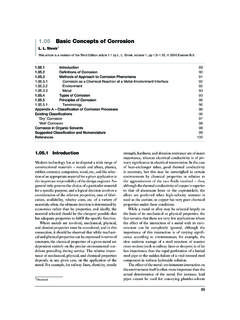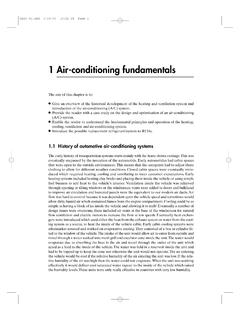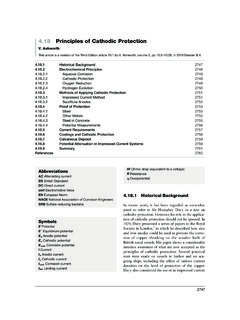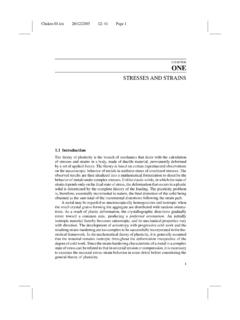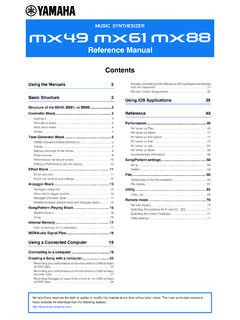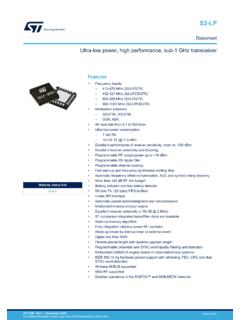Transcription of Chapter 9 Design Constraints and Optimization
1 OverviewConstraints are used to influence the FPGA Design implementation tools including the synthesizer , and place-and-route tools. They allow the Design team to specify the Design performance requirements and guide the tools toward meeting those requirements. The implementation tools prioritize their actions based on the Optimization levels of synthesis, specified timing, assignment of pins, and grouping of logic provided to the tools by the Design team. The four primary types of Constraints include synthesis, I/O, timing and area/location Constraints influence the details of how the synthesis of HDL code to RTL occurs. There are a range of synthesis Constraints and their context, format and use typically vary between different tools. I/O Constraints (also commonly referred to as pin assignment), are used to assign a signal to a specific I/O (pin) or I/O bank.
2 I/O Constraints may also be used to specify the user-con-figurable I/O characteristics for individual I/Os and I/O banks. Timing Constraints are used to specify the timing characteristics of the Design . Timing Constraints may affect all internal timing interconnections, delays through logic and LUTs and between flip-flops or registers. Timing Constraints can be either global or path-specific. Area Constraints are used to map specific circuitry to a range of resources within the FPGA. Location Constraints specify the location either relative to another Design element or to a specific fixed resource within the FPGA. Design Constraint ManagementOne of the most important constraint implementation issues is the wide range of potential configuration overlap and interference. Effective Design constraint implementation requires a solid knowledge and understanding of both the system requirements and the current Design implementation approach.
3 Even with solid knowledge of the Design , there are a broad range of Design constraint combinations that can be applied to the Design . Complex inter-relationships can and do occur between the different constraint types. This inter-relationship KEYPOINTC h a p t e r 9 Design Constraints and Optimization138 Chapter 9may cause a change in one requirement group to require changes in other Design Constraints as well, even when the changes may be relatively minor. This complex interaction leads to some challenges in implementing and managing Design Constraints . It can be beneficial to develop a Design constraint plan in the early stages of a project. An organized plan can help keep the Design from becoming over constrained. The Design constraint plan may be as simple as an outline with bulleted entries. The constraint plan should be viewed as an informal document with an open format that supports efficient up-dates as the project to achieve timing closure is a challenging constraint task.
4 The process of achieving timing closure can be improved by following an organized Design Optimization flow. The second part of this Chapter presents a generalized Design Optimization flow and ad-dresses important topics within each process stage. The selected Design Optimization flow and other text should be incorporated into the Design constraint avoiding Design Over-Constraint Effective Design constraint requires Design analysis and restraint to develop and main-tain the correct constraint balance. Over-constraining a Design will cause the tools to work harder to resolve conflicting or unreasonable requirements with limited resources. Design over-constraint can occur in several different ways. Some of the most common include simply assigning too many Constraints , constraining noncritical portions of the Design , and setting Constraints beyond the required level of performance.
5 An example of Design over-constraint may occur when path-specific timing Constraints have been set to a minimum path delay value far exceeding the required circuit performance. The principle if a little is good then more must be better. is seldom an appropriate philosophy when constraining an FPGA Design . Over-constraining a Design can result in a significant increase in the time required to place, route and analyze a Design . The result is a longer Design implementation time. Since the Design implementation phase potentially occurs many times during a Design cycle this can have a significant impact on Design efficiency. A more serious Design over-constraint consequence occurs when the place-and-route process can no longer successfully implement the Design within the specified FPGA architecture. This may force an upgrade to a larger or faster speed-grade FPGA component if the over-constraint conditions are not avoid Design over-constraint a few simple guidelines should be followed.
6 Start by constraining only the highest performance circuits and then add additional Constraints as required in an iterative approach. Additionally try to leave significant margin within area Constraints and avoid constraining lower performance circuits unnecessarily. A more detailed Design Optimization flow will be presented later in this Synthesis Constraints The types, syntax and context of synthesis Constraints generally vary between tools. Table lists some of the synthesis Constraints the Xilinx Synthesis Tool (XST). KEYPOINT139 Design Constraints and Optimizationtable XSt synthesis constraintsBOX_TYPELOCREGISTER_POWERUPBU FFER_TYPELUT_MAPRESOURCE_SHARINGBUFG (CPLD)MAPRESYNTHESIZEBUFGCEMAX_FANOUTRLO CCLK_FEEDBACKMOVE_FIRST_STAGEROM_EXTRACT CLOCK_BUFFERMOVE_LAST_STAGEROM_STYLECLOC K_SIGNALMULT_STYLESHIFT_EXTRACTDECODER_E XTRACTMUX_EXTRACTSHREG_EXTRACTENUM_ENCOD INGMUX_STYLESLEWFSM_ENCODINGOPT_LEVELSLI CE_PACKINGFSM_EXTRACTOPT_MODESLICE_UTILI ZATION_RATIOFULL_CASEPARALLEL_CASETIGINC REMENTAL_SYNTHESISPERIODTRANSLATE_OFFIOB PRIORITY_EXTRACTTRANSLATE_ONIOSTANDARDRA M_EXTRACTUSELOWSKEWLINESKEEPRAM_STYLEXOR _COLLAPSEKEEP_HIERARCHYREGISTER_BALANCIN G SLICE_UTILIZATION_RATIO_MAXMARGINEQUIVAL ENT_REGISTER_REMOVALREGISTER_DUPLICATION S ynthesis Constraints are used to direct the synthesis tool to perform specific opera-tions.
7 As an example, consider the synthesis constraint CLOCK_BUFFER. This constraint is used to specify the type of clock buffer used on the clock port. Two important synthesis Constraints that can be used to optimize a Design implementation are REGISTER_BAL-ANCING and INCREMENTAL_SYNTHESIS. Register balancing is used to optimize performance, and incremental synthesis is used to reduce synthesis runtime. Register balancing is used to meet Design timing requirements by moving the placement of Boolean logic functionality across register boundaries. Regis-ter balancing can increase circuit clock frequency. This improved performance is gained by adjusting the relative path delays. There are two categories of register balancing and they are referred to as forward and backward balancing. Forward register balancing seeks to move a set of registers located at a LUT s input to a single register at the LUT s output.
8 Backward regis-ter balancing is based on the opposite principle. The synthesis tool works to move a register located at a LUT s output to a set of flip-flops at the LUT s input. At the end of the process, the total number of registers in the Design may be increased or primary objective of incremental synthesis is to reduce the total time it takes to compile the Design . This is performed by synthesizing only the portion of the Design that has changed. Synthesis tools may have different switches or Constraints within the synthesis 140 Chapter 9phase to support this approach. Two other factors that can significantly influence the syn-thesis phase include preservation of the implemented Design hierarchy, and the proper use of Design pin Constraints The first question that comes to mind when considering pin assignment is, Why not let the FPGA tools assign pins?
9 This is a common question for designers to ask, since the FPGA tools are trusted to place and route the Design . However, there are several factors that influ-ence software-controlled resource location assignment. One of the primary FPGA placement directives is to spread functionality out to avoid routing congestion. With no clear guidance to the contrary, the tools will typically work to spread functionality out across the available resources. As an example, FPGA tools can have difficulty identifying the pins that make up a signal bus and can also have difficulty identifying the control signals associated with the bus. Without knowledge that the signals form a group, the tools do not seek to co-locate the signals even though they may benefit from closer placement. While it may be possible to increase the global Constraints of the Design so that the bus signals and related control signals will be located as a group, the Design team then runs the risk of over-constraining the Design .
10 This can significantly increase the place-and-route time for the FPGA software. Ultimately, the Design team knows more about the desired data flow through the Design than the tools. The Design team should be in a better position to guide and influence the de-sign implementation through informed pin assignments. A Design team using a rapid Design development flow may need to begin I/O assignments very early in the Design cycle. The process of I/O assignment is more involved than simply assigning signals to available pack-age pins. The following paragraphs will present some of the considerations that affect the pin assignment decisions. Assigning board-level signals to FPGA I/O can have a large impact on system perfor-mance. In an ideal world, the critical FPGA functionality would have already been captured, compiled and simulated multiple times before the pin assignment step, allowing the Design team to determine an optimized pin assignment.

